Beautiful Day, and a Pizza Recipe, at the 3rd Annual Minneapolis Bread Festival
If you have time to leave the dough balls at room temperature for 30 to 60 minutes, it’ll be much easier to stretch them thin:
I asked for a volunteer to help me throw pizza dough (optional), and we actually did a cross-table toss to each other (not pictured here). Thanks for being a good sport.
Thanks for all of your help, Jillian:
No toppings? Pita bread works, same dough (try any of our lean doughs, like white, or whole grain. I’ve even made pizza from rye dough.
In these ovens, baking time is about 90 seconds, but they’re at nearly 900 degrees F. At home, where 500 or 550 is the max, you’ll go about 6 to 8 minutes for pita, longer for pizza. But we did have gorgeous farm-fresh toppings from the Mill City Market, vegetables and cheeses. The assortment let us be imaginative:
Mark Wheat, from 89.3 The Current was there to MC the event. Great job Mark, thank you.
The bakers who entered the contest had fantastic wares to show off, by the way. We will be back…
Next month, the new book is out, on October 22, 2013. Preorder here, or click on the photo. We had the cover, but no book to sell at the Market. Next time!
Our own pizza recipe’s here:
Olive Oil Dough from Artisan Pizza and Flatbread in Five Minutes a Day:
3 1/4 cups lukewarm water
1/4 cup olive oil
1 tablespoon Red Star Yeast
1 to 1 1/2 tablespoons Kosher salt
2 tablespoons sugar
7 1/2 cups (scoop and sweep) all-purpose flour
Toppings:
1/3 cup tomato (Sauce recipe p. 109 or drain diced tomato straight from the can)
3 ounces Fresh Mozzarella, cut into 1/2-inch chunks
Fresh Basil
Olive oil for drizzling over the top before baking
Pinch of salt
Flour, cornmeal or parchment for the pizza peel
To make the dough: Use our dump and stir method of mixing the dough in a 5-quart Container with Lid, using a Danish Dough Whisk or wooden spoon. Then cover the container, not airtight and let it rest for about 2 hours on the counter. The dough can then be used right away, but it is much easier to handle once it has been thoroughly chilled. The dough can be stored in the refrigerator for 2 weeks!
To make the pizza:
Preheat your oven to the highest setting, which will be 500 to 550°F, with a pizza stone in the bottom 1/3 of the oven. Depending on the thickness of your stone this can take between 20 and 40 minutes.
Pull out an 8-ounce piece of dough from your bucket and quickly form it into a ball, no more than 30 seconds of work. Let it sit on the counter while you gather your toppings.

Roll the ball out into a 1/8-inch-thick round. If the ball is resisting just let it sit for about 5 minutes and it will relax and allow you to work with it.
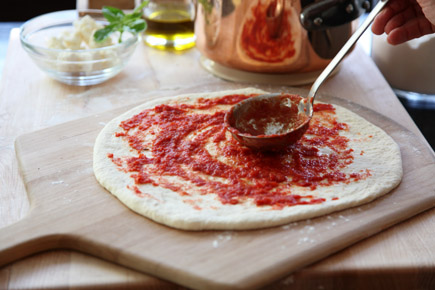
Sprinkle a Pizza Peel with flour. Spread the tomato over the dough.
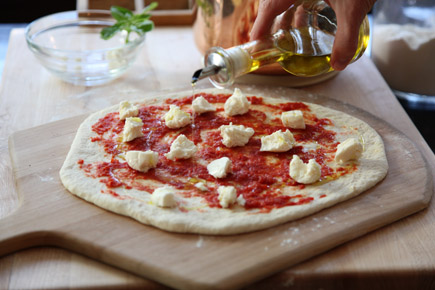
Place the chunks of cheese over the sauce and drizzle with the olive oil.
Check for doneness in about 8 to 10 minutes, turn the pizza around if it seems to be browning on one side more than the other. It may take up to 5 more minutes.
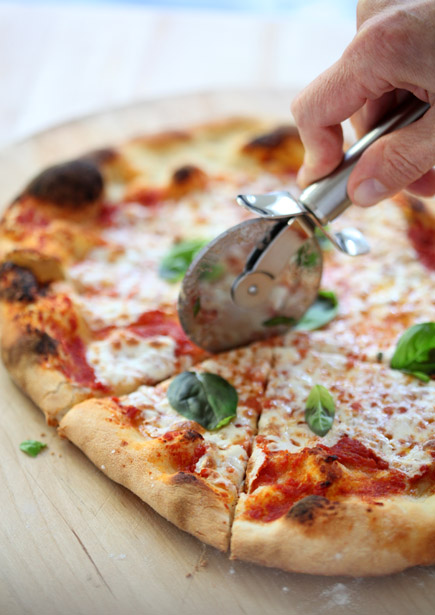
Let the pizza cool slightly, so the cheese can set a little before cutting with a Pizza Cutter. This is best done on a cooling rack if you want to keep a crisp bottom crust.
Note: Red Star Yeast is a sponsor of BreadIn5 LLC’s promotional activities.
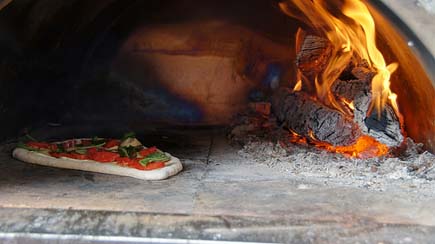


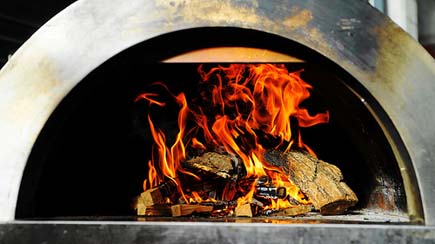
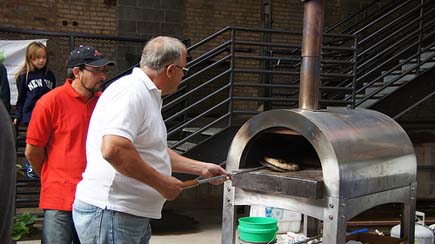
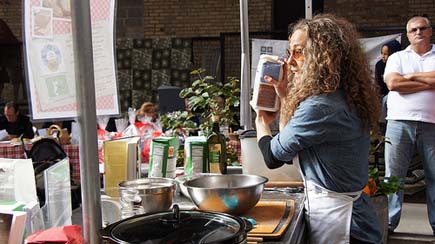
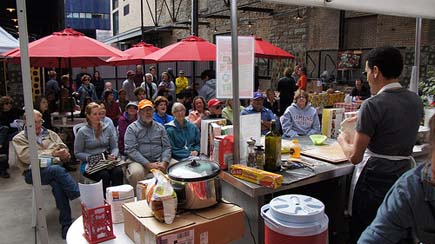
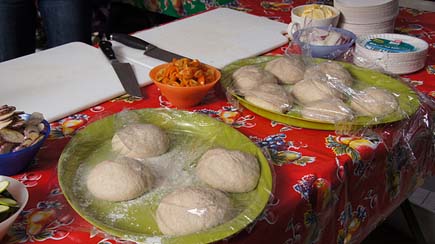

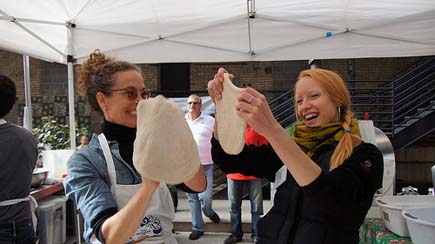

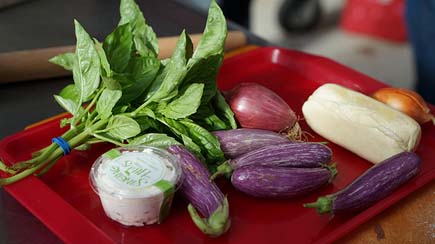
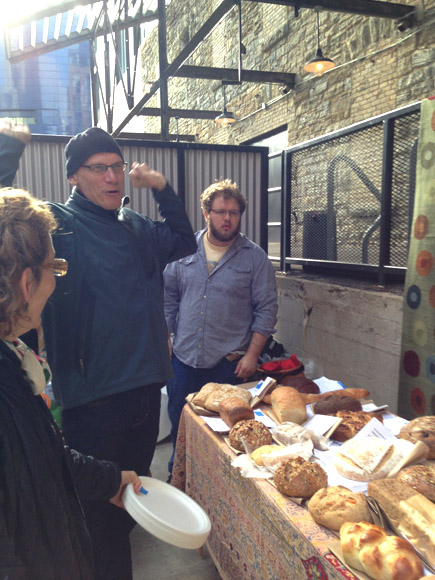
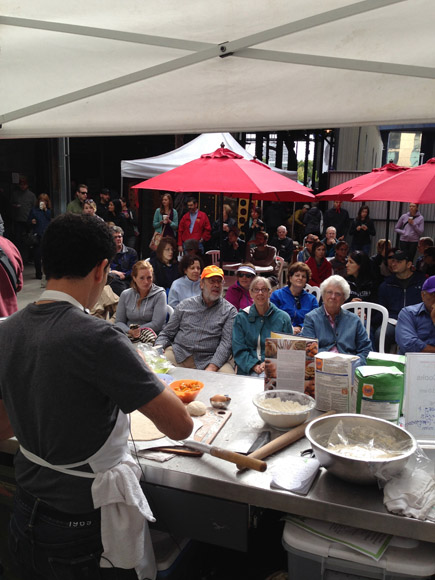


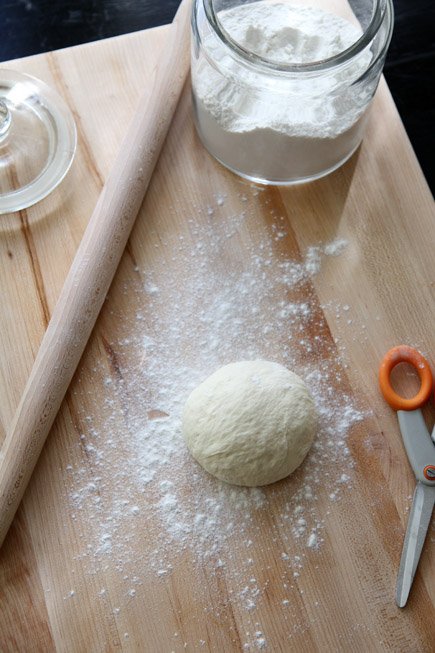

What is the name of the oven pictured? It is available for purchase or do they have plans that can be use to make one?
Love your books. I have all three and have given them for presents. Everyone love the bread I make using your books.
This is custom-built by Lorenzo Ovens, 651.890.6991 or [email protected] (Lorenzo Torregrossa). Tell him Jeff sent you!
It says the new book will be available in October 2014. ?????
Thank you Helen, will fix!
I feel like I have been under a rock because I *just* discovered *white* whole wheat bread. I have all three of your current books. While I want to make healthier breads, when I tried some of the recipes from the “healthy” book by husband just could not accept the taste or the texture. I get him to eat the bran bread fro the 1st book, but that is about it.
I am hoping I can be a bit healthier without him suspecting if I swap out some of the white all-purpose for the www.
For both the master bread recipe in book 1 and the master pizza recipie in the pizza book, what would you suggest?
Awesome books – I am looking forward to your new book!
Thank you for EVERYTHING!
~Mary
Thanks Mary. You can swap WWW one-for-one with regular WW. In book one, try the Light Whole Wheat on page 74, swapping in WWW. You can even increase the proportion of whole-grain, up to 3 cups (decrease AP to 3.5 cups), and increasing the water by 1/8 cup (2T).
In the Pizza book, you can try the same kind of swap, the recipe’s very similar.
Jeff,
Thanks for the info, but I am confused by what you mean when you say in the “In the Pizza book, you can try the same kind of swap”. Would I modify the “100% whole wheat” recipe on p. 82? Or the “lighter whole wheat” on p. 82? I have never used either of these recipes; it seems like it would be different in taste/texture since there is sugar and olive oil in the recipe.
Just wanting to get the best results 🙂
Thank You!
Sorry, I meant the Master recipe in Chapter 5 of the pizza book, you can swap in WWW for some of the white flour, with the caveats I mention above if you go high in whole grain. You can also swap WWW for the WW in the recipes on page 82-84 in the Pizza book, and those swaps are just 1 for 1.
I’m slowly working my way through all 3 of the books to great success and accolades, yes, I give most of the credit to you both. The last time I made pizza it overflowed and left the baking stone covered with thick black intractable patches of carbonized cheese and dough. How can I clean the stone?
I use a metal dough scraper for problems like this, something like https://www.amazon.com/OXO-Good-Grips-Pastry-Scraper/dp/B00004OCNJ?&camp=212361&linkCode=wey&tag=arbrinfimiada-20&creative=380725. That won’t get rid of the discoloration that penetrates the surface, but that’s normal– these stones look ugly after a few uses.
I used to be a good baker for yeast breads and sourdough breads and pancakes, but hadn’t had time to do any baking for many years. I found your websites/books and got so excited that I bought Artisan Bread in Five Minutes a Day, Nov 2007 (Kindle), Healthy Bread in Five Minutes a Day, Feb 2010 (Kindle and Hardcover), Artisan Pizza and Flatbread in Five Minutes a Day, Oct 2011 (Hardcover), and The New Artisan Bread in Five Minutes a Day, Oct 2013. Your methods will allow me to get back to fresh breads! I’ve been trying very hard to get any of your recipes to work for me, but not being successful at all. I know it’s my fault because after reading your FAQ for “Dense crumb: What am I doing wrong?” I see I’ve made every mistake listed. I have purchased all the tools that will help me correct my errors: scale for weighing by grams, Brodman & Taylor Bread Proofer, thermometers (oven and internal temps), non-stick 8-1/2 by 4-1/2 by 2-3/4-Inch baking pans, non-stick 9x4x4 Inch pullman pans, 6-Quart Storage Containers, 5.5 and 8 Inch Round Brotform, and everything else that looked cool. I think I’m close to getting it right now, but no matter what recipe I try I get the same problem – dense crumb. I think I’ve narrowed the problem down to the 1st proofing and the fact that I have no idea what is considered ‘room temperature’. In California the room temp during the summer is 78 – 85 degrees and the winter is 68 – 72 (if you’re following the requests for energy conservation) so I really don’t know what would be considered a normal room temperature. My other concern is over proofing because your yeast recipes are on serious steroids (lol). Every type bread I try rises to the top of the 6-quart storage container in less than ½ the time expected and NEVER collapses, even after refrigerating. The only way I get it to collapse is to pull it away from the sides of the container which may be having the same effect as kneading. The dough looks like a spider web as I’m pulling it away from the sides of the container.
An example of one of the recipes I’m using is HBin5, page 92, Soft White Whole Wheat Sandwich Bread. I’m using the scale and weighting the ingredients by grams. I used the pullman pan, 2-lbs dough, 350 degrees, for 50 minutes with an internal temperature of 195 degrees. The bread rose to the max height you recommended within 25 minutes, so I had to go ahead and put it in the oven earlier that I was supposed to. The bread was a nice golden brown, but a little too dense and may have been a little too moist. My questions:
1. What temperature should I be using for the ‘allow to rise’ instructions when using my bread proofer
2. Should I be pulling the dough away from the sides of the container before putting the dough in the refrigerator for chilling or what should I be doing?
3. Any other help, thoughts much appreciated!
Thank you for all your work and interactions with us.
1. Anywhere from 68 to 72 degrees F should do it.
2. It generally doesn’t matter, though I usually “neaten” up the surface, and this amounts to pulling the dough away from the sides of the container.
What kind of flour are you using, what brands? Are you making any substitutions at all? For the HBin5 recipes, are you using vital wheat gluten? Are your basic recipes coming out too dense, like the Master recipes in chapter 5 of all the books? How about the pizzas?
Also, may prefer the low yeast version of our recipes– can go to 1 tablespoon, or even lower. See our FAQ tab and click on Yeast: can it be decreased in the recipes?
Jeff,
I’m using GM for all flours: unbleached white all-purpose, unbleached whole wheat, unbleached white whole wheat, and I have a better for bread that I haven’t used yet. The bread recipe does use vital wheat gluten – I’m using Bob’s Red Mill. In the beginning I made substitutions, but now I’m just following the recipes ‘as is’ until I can learn what the dough textures should look and feel like. The 2 recipes (the sandwich recipe I used for my example and the NABin5 Master Recipe) I decided to focus on right now are both coming out too dense.
I haven’t tried the pizza/flatbreads yet, but those recipes will definitely be in high demand at my house. We will also use the NABin5 Master Recipe and HBin5 Master Recipe. I will also be making all three of those master recipes with sourdough starter instead of yeast.
I really appreciate your time and response. There are so many recipes that I know my family will enjoy! 🙂
Sheila: Well, your density problem is certainly not because of ingrdients–those are what we test with. If you’ve already tried the 90 minute rest-time after shaping, and everything else on the “Dense Crumb” page, I’m thinking that you’re just going to find this bread more dense than your preference. I’d have to say that our results are denser than most breads available in the US, whether from a bakery or the supermarket. One other thing, any chance you’re measuring differently than we do, see https://bit.ly/ruTXhZ for a video.
You may prefer our dough baked as a flatbread–those are definitely less dense.
Thank you for your response. Once I figured out that whatever I thought I knew was meaningless for your method, I purchased all the tools and brand ingredients that you used to standard everything for us. That’s why I was surprised when both the recipes still had problems. Your answer to question 1 is a probable solution for some of my issues. I was proofing at 82 degrees and higher on some days. That is why I wasn’t able to let the bread rise for 90 minutes. I’m going to adjust when I proof the bread so that I can get the full 90 minute rise in. If the temperature adjustment doesn’t fix that issue, I’ll decrease the amount of yeast to 1 tablespoon.
I was looking at all my ingredients and found out that the white whole wheat flour is 6 months past it’s ‘best used by’ date ( and I just bought it) and really doesn’t smell fresh at all. I’ll return it to the store and get some flour that has a good expiration date and see if that doesn’t help fix the issue with the sandwich bread recipe.
I’ll report back to you as soon as I’ve had a chance to try both recipes with the ‘fixes’ in place.
Thanks again! Sheila
Oops – forgot to answer your question for measuring…
I switched to measuring by weight as grams using the Primo Digital Multifunctional Scale with the tare feature.
Great Sheila, let us know how you make out.
Hi Jeff, sorry it’s taken so long to get back to reporting my results. So far I’ve had success with these recipes: HBin5, page 92, Soft White Whole Wheat Sandwich Bread; HBin5, page 92, Brioche a Tete; NABin5 Master Recipe; and NABin5 pg 307, Sticky Pecan Caramel Rolls. The family is very happy the breads.
I want to make some Naples-style pizza dough. The recipe calls for ‘bread flour’. Would Gold Metal Better for Bread be a good choice of flours for recipes calling for bread flours that should be high gluten or strong flours?
Thanks for your time and help! I’ll sign as SheilaA because I see there are several other Sheila users now.
Glad to hear of the good results.
GM BfB would be a good choice. We have a recipe like this in our pizza book (…https://amzn.to/eo10NJ), on page 75, though my understanding was that Naples-style didn’t call for high-protein flour. Rather, a low-protein flour, with a very little bit of high-protein thrown in to give some stretch. For Naples-style, we just call for all-purpose (see https://artisanbreadinfive.com/2013/09/24/beautiful-day-at-the-3rd-annual-minneapolis-bread-festival-sponsored-by-gold-medal and scroll down for the recipe). You could skip the olive oil mixed with the dough for true Naples-style (they drizzle it on the finished pizza instead).
I forgot to ask: If the recipe calls for bread / strong flour, do I need to add the extra water I see listed for a required adjustment on page 6 of the pizza book when talking about high gluten flours?
Not if the recipe’s already adjusted for that. If you’re swapping BfB for AP in a recipe that was developed for AP, then yes, you do.
I appologize for not specifing the book / page of the recipe I’m interested in. It is from the Pizza and Flatbread book, page 76. The ingredients chart says “Bread flour (sometimes labelled “high-protein”…)”. I don’t know if the recipe has already been adjusted for all water that would be needed.
Thank you.
Nothing to adjust, that one (and all our recipes) was tested as written.
I just bought a bag of flour and it has your new bread recipe on back. I had a couple ?:
– it says 6 cups flour – can I change one cup to whole wheat white flour and maybe a half cup to ground flax or oat bran?
– I bought a stainless steel bowl to store the dough in – can I just put saran wrap loosely over it in the frig- it didn’t come with a lid…
Thanks – I have your new book ordered – Best,
Greg
Hi Greg,
So glad you found the recipe. We always suggest making it as it is written the first time, just so you will know what the consistency of the dough is meant to be. After that you will know what you are going for when you try to make substitutions. You can change 1 cup of the all-purpose with whole wheat or other flours without having to make any other changes. I would suggest adding 1/4 cup of flax and see how you like the dough. If you like it, then try increasing it in the next batch. The problem is that flax has no gluten, so it may make the bread a bit too dense.
We have many recipes in our Healthy Bread in Five Minutes a Day book that have whole grains and flax. You may want to take a look.
Thanks, Zoë
Thanks Zoe – the “healthy bread” book sounds like it would be a good fit! Do you have updates in your new book that would apply to this older book? Should i get both?
Also- my bowl does not have a lid – does it work to “cover loosely” with saran wrap and store that way?
Hi Greg,
There are many updates to the new book, which include new recipes, more picture, lots of techniques and deeper explaination for some of the old techniques. If you have and use the older version, I do think you’ll find lots of the new material helpful.
Yes, saran wrap is perfect to use over the dough.
Thanks, Zoë
We made pizza on the open fire this summer and it was fantastic! My fussy niece who eats hardly anything said it was the best pizza she ever ate. I used 1/2 WW and 1/2 splet flour. We found we had to have a flame – and oil the grill (just a tad). Also to ensure the dough was cooked all the way – we cooked one side until you could handle the dough without it changing shape and flipped it – cooked the other side the same – and flipped again – putting the toppings on the newly hot/flipped up side. Then continued to cook until browned on the bottom and the toppings were hot/cheese melted. Here we found at times we needed to move the pizza off from the direct flame every so often. We made individual size using 4 ounces of dough. I wish I could post a picture of our pizza’s over the camp fire. And for breakfast the next day – I made one with butter, honey and cinnamon – yummy!
So sorry for the typo – spelt (instead of splet) 🙂
I am using the olive oil dough from ABin5 revised edition pg 214. I am at high altitude in Colorado (6,000ft) if that possibly makes a difference. My question is that when I bake the pizza, the dough puffs up like a souffle. I’ve even gone to pricking the dough all over with a fork before putting the sauce and toppings on. Taste is unaffected and is great but the giant poofing has me stumped. Any ideas?
Hi Brian,
This could be a result of the high altitude or it can be a matter of the crust being too thick. You may want to try a thinner crust next time: https://artisanbreadinfive.com/2012/01/25/secrets-of-cracker-crust-pizza-plus-our-tv-segment-with-saturday-night-lives-colin-quinn
Thanks, Zoë
Thank you for the quick reply. I’ll try and roll the dough out thinner next time. I’m also going to let the dough rest more before baking and see if that makes a difference as well.
Zoe, great advice! Worked like a charm. Didn’t see any way to post photos but here is the fruits of my labor. From pizza in five, Neapolitan recipe using all 00 flour
https://i90.photobucket.com/albums/k264/brianb10/629bdd5326e917afa71b71e94f977abe_zpsdea10188.jpg
Great! Another way to post photos is on our FAQs page, click on Photographs: Can I post pictures to this website?
… there’s actually a Flickr group you can join, or just use Instagram (we’re instagram.com/breadin5), follow us and I think we can see yours.
Absolutely you can post the photo. I’d be honored 🙂
I’ll look into the FAQ and other sites. Thanks for the info.
I have your healthy bread in 5 book as well as your standard book. I want to make pizza’s then vacuum seal and freeze them for later use (bye bye commercial frozen pizza).
How do I go about doing that? I did it with the regular Master recipe and the crust didn’t really “poof” and it was quite heavy, even though the regular bread I made from that batch was perfect.
I’m afraid to try it with the Whole Grain master (which was my ultimate goal) so I figured I would post my very first question!
Hi Megan,
You have many options. We have an entire book on pizzas and go into lots of details about freezing the dough or pizzas. Here are a few options:
1. you can freeze the dough balls, which means you just have to roll it out when you want pizza.
2. You can roll out the dough onto parchment, then freeze the dough and wrap it once it is hard. You can then top it and bake it.
3. You can parbake the rolled out dough and then freeze it. You can then top it and bake it.
Hope those help. Zoë
Hi there…I LOVE your breadmaking method and have ABin5 and HB. We used to make your pizza dough recipe every week for family pizza night, but found it sticky and difficult to work with…I am noticing that this above Olive Oil Dough recipe is different than the one in ABin5…is this recipe above hopefully going to solve my sticky problem? No matter how fast we rolled out the dough, how long refridgerated, etc. it just became a nightmare to transfer from the cutting board to the peel, and then to the oven. Could you let me know the differences in the 2 recipes? (I don’t unfortunately have the pizza book…yet)
Thanks so much,
Amanda
They’re not meaningfully different from each other. Sounds like your dough is just too wet. So..
1. Check your measuring technique: Weigh the flour, or https://artisanbreadinfive.com/2010/04/28/how-we-measure-our-flour-using-the-scoop-and-sweep-method
2. What brand flour are you using? See FAQ called “Flour varieties…”
If that’s not it, just use a little more flour so you can handle the dough.
Thanks so much for your response…I am using Canadian flour..it is unbleached all purpose, but I just realized that this brand is still “enriched and pre-sifted”…I am wondering if that would have anything to do with it..but I will be adding the extra 1/4 cup with hopefully better results..the flavour of the dough is amazing!!! Best pizza dough ever!!
Surprised because Canadian flour has higher protein than US, but let’s see what happens. Enriched and pre-sifted aren’t issues, all commercial flour is E and PS.